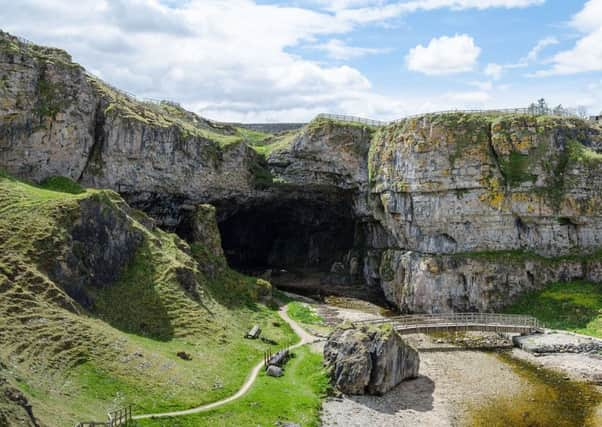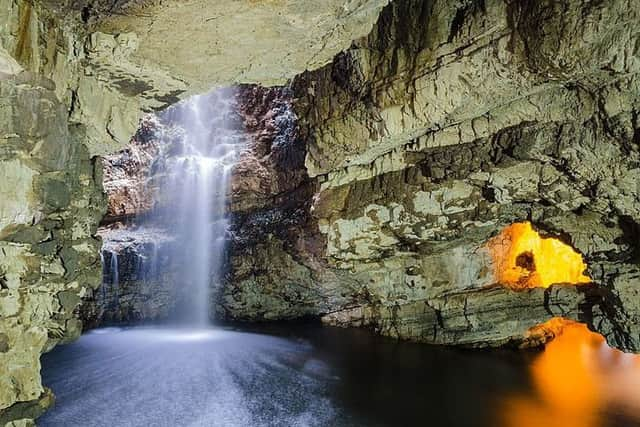Secrets of Smoo Cave: from whisky to Vikings and murder


Smoo Cave, at Durness in Sutherland, is the largest coastline cave in the British Isles and has provided shelter for thousands of years.
It is believed to have been a Stone Age home more than 5,000 years ago with Norse settlers later gathering here to repair boats and fish for herring.


Advertisement
Hide AdAdvertisement
Hide AdThe name Smoo Cave is likely to have come from the Norse ‘smjugg’ or ‘smuga’ meaning a hole or hiding-place.
While proving to be a safe harbour from the pounding North Sea, Smoo Cave has also inspired some rather romantic responses, such as an 1814 diary entry from Sir Walter Scott, who visited on September 19 that year.
On noting his lamp on the dew-covered stalactites, Scott described it as the “effect of ten thousand birthday candles.


“A water kelpie or an evil spirit of aquatic propensities could not have chosen a fitter abode and to say the truth I believe at our first entrance and all our feelings were afloat at the marvelling of the scene the unexpected splashing of a seal would have routed the whole dozen of us.
“Impossible for description to explain the impression made by so strange a place.”
Many local legends surround the cave, including one of highway man McMurdo who patrolled this far flung corner of the north during the 1500s.
McMurdo murdered his victims by throwing them down the blowhole into the cave with the highwayman buried in a tomb at nearby Balnakeil Church.
Advertisement
Hide AdAdvertisement
Hide AdAnother claim is that two excise men seeking out illicit whisky distilling in the mid 1700s were drowned by a local man, Donald Mackay, who was bribed by the government agents to help in the search for an illicit still rumoured to be in the cave.
“On this particular occasion on which Donald Mackay was employed by them, the Smoo Burn was in high flood, and on pushing off from the anchorage inside the second chamber of the cave, Mackay observed that the two gaugcrs were literally terrified, as he rowed them into the spray of the waterfall inside it.”
It added: “Donald Mackay, being a strong swimmer, purposely manoeuvred his craft into dangerous proximity to the crashing furies at the base of the fall and purposely capsized the boat, when he swam to safety, leaving the two unfortunate Inland Revenue officers to drown amid the angry, troubled waters.
“Rumours has it that one of the bodies has never been found to this day; but the ghost of this lost man appears in the foam below the waterfall inside the second chamber of Smoo Cave when the burn is in high flood.”
While Smoo Cave is ripe for myth and superstition - some believe it to be a gateway to the nether world - detailed archaeological studies have been carried out to increase understanding of who may have lived here.
In 1992 an archaeological dig on a midden site - similar to a rubbish tip- concluded the cave was one of the of the most northerly habitation sites in the British mainland.
The upper layers of the midden, which was packed with shells, dated to the Iron Age, around 3,000 years ago.
Advertisement
Hide AdAdvertisement
Hide AdThe deeper the archaeologists went, the older the remains with butchered bones and small flakes of quartz discovered in the midden’s base.
It is thought they dated from Mesolithic Period, or the Stone Age, when the earliest human inhabitants arrived in the Highlands between 8,000BC and 4,000BC.
Evidence of Norse activity also emerged during the 1990s when a team of Glasgow University archaeologists headed to Smoo Cave, which has three separate offshoots - Glassknapper’s Cave, Antler Cave and Wetweather cave.
Archaeologists created a picture of high activity, with a peg carved from antler, a bone spatula and a broken bone needle, with a perforated round head - which may have been used to make and repair fishing nets - discovered.
A Square-headed rivet and iron slag “strongly suggested” that boats were hauled up to the beach to repair
A number of marine shells, including oysters and limpets and animal bones, including deer, suggest the diet of the day.
Norse settlements have been found in Caithness, including Dunnet Bay, around 46 miles away with only a burial site recorded nearby.
Advertisement
Hide AdAdvertisement
Hide AdArchaeologist Tony Pollard, who led the excavation in the early 1990s and is now Director of the Centre for Battlefield Archaeology at Glasgow University, earlier said the cave may have been used as a temporary stop over by Norse mariners on their voyages from Scandinavia and the Northern Isles to the Western Isles, Ireland and the Isle of Man.
Guided geological tours of Smoo Cave, part of which are undertaken by boat, are run over the summer months.
